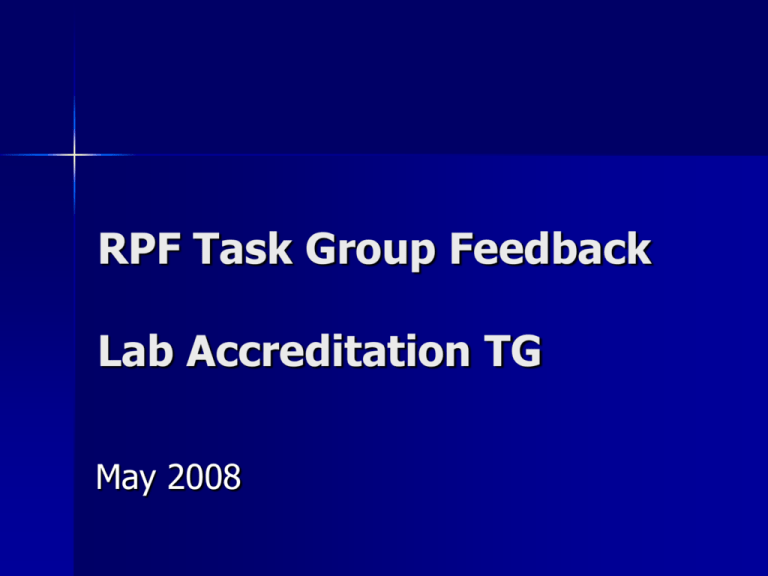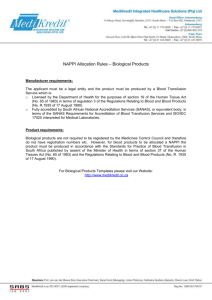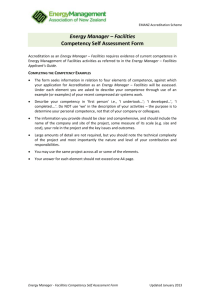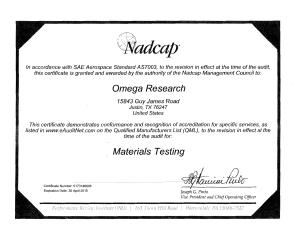RPF Task Group Feedback Lab Accreditation TG Skills
advertisement

RPF Task Group Feedback Lab Accreditation TG May 2008 Background ISO 17025 Accreditation ISO 17025 Accreditation looks at 5 areas in a laboratory: – Environment – Equipment – Methods – Measurement validity & traceability – Personnel competence SANAS – assessors, site lab accreditation, training, etc 1. SANAS – assessors, site lab accreditation, training, etc SANAS has put together a strategic plan for Civ Eng laboratories which covers a number of areas incl test methods, PT schemes, no of assessors and site lab accreditation. Technical assessors: – 3 at present available with a 4th very soon. (3xGP & 1xEC) with capacity for 9 assessment p.a. each – SANAS will be training a further 3 in Aug this year (preferably BEE) – Targeting academics for certain areas (esp. cement production industry) due to competition. Forward possible candidates to me: damhuisr@nra.co.za or marlanp@sanas.co.za www.sanas.co.za for more information on SANAS 1. SANAS – assessors, site lab accreditation, training, etc Site lab accreditation: – Draft doc based on OZ model (NATA) but not accepted by SANAS – Working committee to be set up by SANAS at next STC meeting in June / July. 2. ISO 17025 REQUIREMENTS: Measurement validity & traceability ISO 17025 demands in Section 5.9 that laboratories assure the quality of the test by one of the following: – – – – – Reference materials Interlab comparisons or PT schemes Practical in Replicate testing our environment Retesting of retained samples Correlation of results from different characteristics of an item eg PI vs LS It requires that the selected method should be appropriate to the type & volume of the work. SANAS prefers PT schemes but does not specify the model. 2. ISO 17025 REQUIREMENTS: Measurement validity & traceability High level PT scheme proposal developed for a National Proficiency Testing Scheme NPASR National Proficiency Assessment Services for Roads Pilot study Gautrans & WCPA (2004/05) Based on CLIENT requirements 2. ISO 17025 REQUIREMENTS: Measurement validity & traceability Based on: National scheme. Must be accredited to ISO Guide 43. Must be run independently / sustainable. Industry had certain reservations about the system, esp the cost & frequency of tests. The NPASR System has been broadened to meet the goals of various organizational groups – clients & commercial labs. 2. ISO 17025 REQUIREMENTS: Measurement validity & traceability Broadened system has 3 levels of Prof Testing to be based on national standards: Level 1: National PT scheme (as per original) High accuracy, Relatively High cost, low frequency – tests accuracy of labs’ results, repeatability & reproducibility for various tests. Level 2: Local interlab comp scheme: Medium accuracy, medium frequency – tests lab’s bias precision and systematic errors. Level 3: In-house replicate / repeat testing: Low cost, Medium accuracy, High frequency – tests labs random errors 2. ISO 17025 REQUIREMENTS: Measurement validity & traceability Outcomes required for system: – – – – – As previous system: National scheme with local testing cells. Cells ideally must overlap, Must be accredited to ISO Guide 43 Must be run independently / sustainable. Levels must feed into each other Similar basis of non-conformance for all labs ie similar actions required by labs for similar rating. Due to priority – a partnership is being developed between the taskgroup and possible service provider/s to develop the Level 2 and 3 systems. Level 1 will continue being developed and expanded. Program:- Uniform Level 2 & 3 Inter-lab comparison system in place by late 2009. Rest to follow thereafter. Possibility of NLA running scheme? Level 2 Local interlab comp scheme Medium accuracy medium frequency Tests lab’s bias precision and systematic errors Replicate tests should be correlated with Level 2 results. Level 3 In-house replicate / repeat testing Low cost, Medium accuracy, High frequency Tests labs random errors Increase in frequency Lab limits cannot be set outside R&R & UoM values Level 1: National PT scheme: High accuracy, High cost, low frequency tests accuracy repeatability & reproducibility Costs R&R values, typical UoM values set Human resource development From Les Sampson’s presentation Skills development and HR growth only a priority in the last 2 years Inappropriate qualifications at all levels – CETA; Materials testing; Pavement Engineering Development of Materials testing Competence Several Civil Engineering (materials oriented) qualifications: – – – – – – – – Generic B Eng, B Tech & N-Dip National Certificate in Pavement Engineering - NQF 6 Generic National Certificate in Construction– NQF 1 – 4 Generic certificates in Engineering – NQF 5 – 6 National Certificate in Construction materials manufacturing National certificate in materials testing NQF 2 – 4 Construction Material testing qualification ??? A number of them appear to be targeting a similar market Duplication of efforts?? Is there a single strategic coordinated approach to developing these qualifications? 3. Development of Materials testing Competence Construction Materials Testing qualification 22 March 2006, workshop held for establishment of a ‘Construction Materials Testing Qualification’ on behalf of the ‘Construction CETA’ A decision was made for the establishment of a – Materials Tester’s qualification and a – Materials Tester Competency certification. These two frameworks were accepted in principle by Construction CETA. 3. Development of Materials testing Competence Construction Materials Testing qualification – Generic qualification covering various aspects of lab testing, from NQF 2 – 4. – Rank the complexity of test in the various streams and modify the range statements of the unit standards – Under development with SAQA – in process of review. Workshops to be held soon. Even though not yet approved, some training bodies are aligning training material to cover various aspects of course. Eg AsAc Materials Testers’ courses on questionnaire. 3. Development of Materials testing Competence National Laboratory Association Materials Testers Competency Scheme NLA approached by industry to set up competency scheme based on Materials Testers’ qualification. Operator to be evaluated for competency to carry out a test method. The instrument consists of a theoretical section and a practical section. This competency evaluation instrument can also be used when evaluating practical work for National Diploma (Civil) / Materials Diploma students. Scheme to be SANAS accredited to ISO 17024 Personnel Competence. SANAS supported - will reduce burden of proof for tester competency. Funding needed for go-ahead 3. Development of Materials testing Competence 3. Development of Materials testing Competence NLA Testing & Measurement Conference Annual 2 day generic laboratory conference Industry specific streams eg calibration, water, electrical, wood, etc Deals with several common lab accreditation subjects: – – – – – UoM PT schemes Validation of tests Equipment handling & calibration etc 3. Development of Materials testing Competence NLA Testing & Measurement Conference Topic for 2008: Risk management through making quality measurements 25-27 August 2008 For more details see www.nla.org.za 3. Development of Materials testing Competence NLA Testing & Measurement Conference NLA has offered to host a civil engineering stream. Advantages: – Comment and feedback on industry progress eg test methods, PT schemes, etc – Labs can workshop common issues – UoM, R&R, interpretation of results – Network with other laboratory streams to discuss common issues. – CPD points for materials techs / engineers Summary & way forward?? RPF / RECOB to support SANAS in their efforts to sort out our laboratory issues. A co-ordinated approach to education & training through RECOB / RPF nominations for mandated persons on various industry boards (ECSA, SAQA, CETA, etc) in order to expedite / unify processes. Establishment of the NLA Materials testers competency scheme. Establishment of Civil Eng stream at NLA annual T&M conference.





